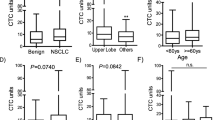Summary
Background
The computed tomography (CT) is the “golden standard” for the assessment of lung cancer progression due to its ability to clearly display the radiomorphologic characteristics. As lung cancer mortality is very high, more comprehensive approaches may be needed for its earlier diagnosis. The research hypothesis was to investigate the relation between the CT morphologic characteristics (size, stage, and edges) of pulmonary lesion and the extent of release of a soluble fragment of cytokeratin 19 being a part of the cytoskeleton of lung epithelial cells.
Methods
This is a retrospective study including 246 pulmonary lesions being diagnosed and subsequently treated at the University Hospital Centre Zagreb, Croatia. The information about the relevant clinical, radiological, and laboratory facts was collected at the time of diagnosis in 164 NSCLC patients, 52 patients with pulmonary metastases, and 30 benign cysts. CYFRA 21-1 was determined by electrochemiluminescence immunoassay. The nonparametric statistical methods were applied.
Results
There was a positive correlation between the size and CYFRA 21-1 in NSCLC unlike metastases or cysts (p = 0.0001). The highest values of CYFRA 21-1 were seen in advanced stages of NSCLC and lesions with spiculated edges.
Conclusions
The level of CYFRA 21-1 positively correlates with the greatest size of NSCLC measured by CT. The differences in CYFRA 21-1 according to TNM classification are significant (p = 0.0001): higher values were observed in advanced stages and with tumors having spiculated, lobulated, and poorly defined edges. The combination of CYFRA 21-1 and CT may help articulate the malignancy of pulmonary lesions.






Similar content being viewed by others
References
Globocan.iarc.fr (homepage on the internet). Lyon: International Agency for Research on Cancer; 2010 (accessed and cited 23 March 2012). www.globocan.iarc.fr.
Hzjz.hr (homepage on the internet). Zagreb: Croatian Institute for Public Health. Croatian Cancer Registry (updated 12 October 2012, accessed and cited 25 October 2012). http://www.hzjz.hr/rak/novo.htm.
Kent MS, Port JL, Altorki NK. Current state of imaging for lung cancer staging. Thorac Surg Clin. 2004;14:1–13.
Verschakelen JA, Bogaert J, De Wever W. Computed tomography in staging for lung cancer. Eur Respir J Suppl. 2002;35:40S–8S.
Schafer-Prokop C, Prokop M. New imaging techniques in the treatment guidelines for lung cancer. Eur Respir J. 2002;35(Suppl.):71S–83S.
Verschakelen JA, De Wever W, Bogaert J, Stroobant S. Imaging: staging of lung cancer. Eur Respir Monogr. 2004;30:214–44.
Toloza EM, Harpole L, McCrory DC. Noninvasive staging of non-small cell lung cancer: a review of current evidence. Chest. 2003;123(1 Suppl.):137S–46S.
Hyer JD, Silvestri G. Diagnosis and staging of lung cancer. Clin Chest Med. 2000;21:95–106.
Goldstraw P. The 7th edition of TNM in lung cancer: what now? J Thoracic Oncol. 2009;4:671–3.
Chen C, Bao F, Zheng H, Zhou YM, Bao MW, Xie HK, et al. Local extension at the hilum region is associated with worse long-term survival in stage I non-small cell lung cancers. Ann Thorac Surg. 2012;93:389–96.
Lee C, Byun C, Lee J, Kim D, Cho B, Chung K, et al. The prognostic factors of resected non-small cell lung cancer with chest wall invasion: a retrospective study. World J Surg Oncol. 2012;12:9.
Neralic Meniga I, Kujundzic Tiljak M, Ivankovic D, Aleric I, Zekan M, Hrabac P, et al. Prognostic value of computed tomography morphologic characteristics in stage I non-small cell lung cancer. Clin Lung Cancer. 2010;11:98–104.
Atance-León P, Moreno-Mata N, González-Aragoneses F, Canizares-Carretero MÁ, García-Jiménez MD, Genovés-Crespo M, et al. Multicenter analysis of survival and prognostic factors in pathologic stage I non-small cell lung cancer according to the new 2009 TNM classification. Arch Bronconeumol. 2011;47:441–6.
Brundage MD, Davies D, Mackillop WJ. Prognostic factors in non-small cell lung cancer: a decade of progress. Chest. 2002;122:1037–57.
Pujol JL, Boher JM, Grenier J, Quantin X. CYFRA 21-1, neuron-specific enolase and prognosis of non-small cell lung cancer: prospective study in 621 patients. Lung Cancer. 2001;31:221–31.
Molina R, Filella X, Augé JM, Fuentes R, Bover I, Rifa J, et al. Tumor markers (CEA, CA 125, CYFRA 21-1, SCC and NSE) in patients with non-small cell lung cancer as an aid in histological diagnosis and prognosis. Comparison with the main clinical and pathological prognostic factors. Tumor Biol. 2003;24:209–18.
WMA Declaration of Helsinki. Ethical principles for medical research involving human subjects (Internet, accessed and cited 28 May 2013). http://www.wma.net/en/30publications/10policies/b3/.
Silvestri GA, Lenz JE, Harper SN, et al. The relationship of clinical findings to CT scan evidence of adrenal gland metastases in the staging of bronchogenic carcinoma. Chest. 1992;102:1748–51.
Pope RJE, Hansell DM. Extra-thoracic staging of lung cancer. Eur J Radiol. 2003;45:31–8.
Moll R, Franke WW, Schiller D, Geiger B, Krepler R. The catalogue of human cytokeratins: patterns of expression in normal epithelia, tumors and cultured cells. Cell. 1982;31:11–24.
Moll R, Divo M, Langbein L. The human keratins: biology and pathology. Histochem Cell Biol. 2008;129:705–33.
Aktogu S, Yuncu G, Halilcolar H, Ermete S, Buduneli T. Bronchogenic cysts: clinicopathological presentation and treatment. Eur Respir J. 1996;9:2017–21.
McAdams HP, Kirejczyk WM, Rosado-de-Christenson ML, Matsumoto S. Bronchogenic cyst: features with clinical and histopathologic correlation. Radiology. 2000;217:441–6.
Author information
Authors and Affiliations
Corresponding author
Rights and permissions
About this article
Cite this article
Sertić Milić, H., Franjević, A., Bubanović, G. et al. Size, edge, and stage of NSCLC determine the release of CYFRA 21-1 in bloodstream. Wien Klin Wochenschr 127, 465–471 (2015). https://doi.org/10.1007/s00508-014-0678-2
Received:
Accepted:
Published:
Issue Date:
DOI: https://doi.org/10.1007/s00508-014-0678-2




